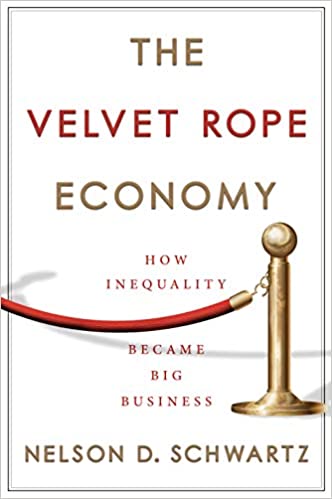You have /5 articles left.
Sign up for a free account or log in.
 The Velvet Rope Economy: How Inequality Became Big Business by Nelson D. Schwartz
The Velvet Rope Economy: How Inequality Became Big Business by Nelson D. Schwartz
Published in March 2020
As academics, we will never make it into the 1 percent. But that doesn't mean that we can't imagine what such a life might be like.
What exactly defines the 1 percent? Schwartz, whose day job is as an economics reporter for The New York Times, offers a helpful definition -- if you earn over $514,000 per year, then congratulations, you are in the 1 percent.
That half a million a year puts you at the extreme low end of the high end. The average income for the top 1 percent is $1,305,000.
To give some context to these numbers, Schwartz defines a middle-class income as falling in the 40th to 75th percentile of wages, which works out to $35,000 to $80,000 per year. You are considered upper-middle class if your salary is between $80,000 and $207,000.
Schwartz does allow, however, that these categories are mostly meaningless if location is not taken into account, as what "it takes to live a middle-class life in San Francisco translates into an upper-middle-class or even rich lifestyle in Toledo."
As The Velvet Rope Economy details, companies have followed a strategy bifurcating their goods and services to sell to either extreme of the income distribution. Whole Foods for the upper-middle class, and Dollar General stores for the formerly middle class.
Airlines are a good microcosm of this approach. The rich get a mostly friction-free travel experience. Top-tier ticket holders board first, have plenty of overhead space and enjoy wide seats and plenty of legroom. All the extra airplane space devoted to business and first-class flyers has resulted in coach seats being squeezed ever tighter together.
As The Velvet Rope Economy explores, the airline model to segmenting customers by income has spread to many more walks of life. In the book, we spend time at sports stadiums such as Yankee Stadium, which feature private suites and cushy seats for the rich.
This pattern is repeated on cruise ships, which increasingly feature ship-within-a-ship areas for high-end cruisers.
Visitors to Universal Studios can buy passes that allow them to jump the lines, provided they are willing to pay multiples of a standard ticket price.
In health care, the rich can contract with concierge physicians. This arrangement buys wealthy patients the ability to enjoy unhurried physician visits. Access to specialists is also enhanced, as concierge doctors can leverage their networks to get their patients' appointments with top providers.
Higher education does not escape Schwartz's investigation in The Velvet Rope Economy. Much of the book is a critique of a higher ed system that seems to have calcified into a protector of privilege, rather than an engine of mobility. Among the wealthiest institutions of higher learning, it is not uncommon to have more students from the top 1 percent of household income than the bottom 50 percent.
While admissions may be need-blind at the most elite schools, the children of wealthy parents retain many advantages in the admissions game. These advantages include attendance at the best public schools (funded by local property taxes in affluent neighborhoods) and expensive private schools. Wealthy students receive enrichment in the form of tutoring and extracurricular activities that are out of reach for middle-class households.
Increasingly, participation in high school sports is inaccessible to middle-class and poorer students, as funding cutbacks have required that schools institute a "pay-to-play" system of fees.
So how can a velvet rope economy be defended?
Schwartz argues that it can't be. He would like to see companies operate more like the Green Bay Packers, the only community-owned franchise in the NFL. The Packers have resisted raising the price of season tickets to levels that only the 1 percent can afford. Good seats at Lambeau Field are still available to middle-class fans.
Other examples of companies that Schwartz identifies that have resisted the velvet rope economy are Southwest Airlines (no first-class seats) and Disney (all ticket holders get three Fast Pass tickets).
What The Velvet Rope Economy is not is a book of policy solutions. There is minimal talk of a Sanders-like wealth tax. There is no in-depth discussion of the merits of free college tuition. Questions such as the taxing of the endowments of wealthy universities, ending the home mortgage deduction or increasing the income tax on top earners are not explored.
Nor does Schwartz suggest that the U.S. should move away from funding public schools with local property taxes. This is not that kind of book.
Instead, The Velvet Rope Economy is a peek behind the velvet rope. For 352 pages, or 12 hours and 33 minutes, if you listen to the audiobook, the reader gets to imagine life as a 1 percenter.
Can you offer a defense of a velvet rope economy?
What are your favorite books about the wealthy?
What are you reading?








